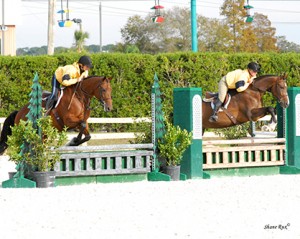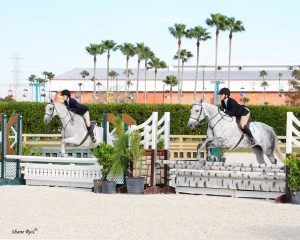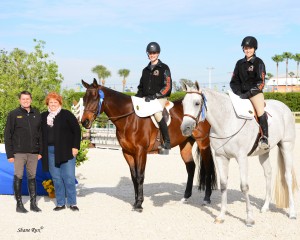New “Tandem/Synchronized” $1,000 Hunter Pairings Class a Huge Hit Among Competitors at 2014 Fl. Gulf Coast
By: Brittany Bevis
A brand new class debuted at the Florida Gulf Coast Quarter Horse Circuit in Tampa, Florida and was met with an outstanding reaction from both spectators and competitors alike. The new $1,000 Hunter Pairings class utilized a unique format in which two horse and rider pairs jumped a course in tandem as well as with synchronization.
“This is the very first time we have done this with Quarter Horses at a show here in Florida,” says Show Committee Chair Peg Edmondson. “It was a non-sanctioned class, so it was just for fun. $1,000 was paid back to the top four places, but we had prizes for everyone in the class that were donated by the sponsors: Turning Point Ranch and Chuck Briggs; The Collection and Robin Petix; Mona’s Embroidery and Engraving; Richard and Elise Cognetti; and Bill Ellis and David Connor.”
A total of nine pairs of non-pro competitors participated in the inaugural event with 18 different horses completing the course.
“How it worked is that the class was only for non-pros,” she says. “There were no professional riders. Riders entered in the show office as a pair using their back numbers and the same horses from the regular horse show. There were two riders and two horses for each pair.”
“As the class was called, we drew the working order by the pairs. The first one drawn entered the arena with their two horses. Between them, the pair chose one rider to be the leader and one to be the follower. They jumped the course, which was predesignated with certain jumps as single jumps and others as dual jumps. For the single jumps, they jumped in leader/follower order. First, the leader jumped and then the follower jumped.”
Edmondson explains that synchronicity and rider communication was vital to ensure that the pairs avoided collision and allowed for plenty of “grace space” in the case of fallen rails.
“When they came to a dual jump, the leader slowed down to let the follower catch up,” she says. “Then, side by side they jumped the dual jump. They literally jumped it together, synchronized. Then, they went on to the middle of the ring and changed the order. The other rider became the leader and the [former] leader became the follower. They proceeded to the next single jump with the new leader and follower. They completed the course with another single jump, and the last two jumps were dual jumps side by side.”
Each pair was scored by the judges and placed by the judges as a team. Some of the pairs showed extra spirit by matching their show ensembles and pairing up into same horse coat color combinations. Winning the class this year was Nicholas Furlong and Grace Baum.
“It was a fun event and everyone loved it,” she says. “We had lots of spectators, and they were really happy with the class. The exhibitors really enjoyed it. They want to do it again next year and people speculate that there will be a lot more entries…”













